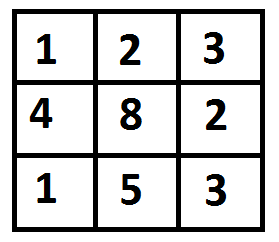给定成本矩阵cost [] []和cost [] []中的位置(m,n),编写一个函数,返回从(0,0)到(m,n)的最小成本路径的成本。矩阵的每个单元代表遍历该单元的成本。到达(m,n)路径的总成本是该路径上所有成本(包括源和目标)的总和。您只能从给定单元格(即,给定单元格(i,j),单元格(i + 1,j),(i,j + 1)和(i + 1, j + 1)可以遍历。您可以假设所有成本都是正整数。
例如,在下图中,到(2,2)的最小成本路径是什么? 
下图突出显示了成本最低的路径。路径是(0,0)–>(0,1)–>(1,2)–>(2,2)。路径成本为8(1 + 2 + 2 + 3)。
/* Dynamic Programming implementation of MCP problem */
#include
#include
#define R 3
#define C 3
int min(int x, int y, int z);
int minCost(int cost[R][C], int m, int n)
{
int i, j;
// Instead of following line, we can use int tc[m+1][n+1] or
// dynamically allocate memoery to save space. The following line is
// used to keep te program simple and make it working on all compilers.
int tc[R][C];
tc[0][0] = cost[0][0];
/* Initialize first column of total cost(tc) array */
for (i = 1; i <= m; i++)
tc[i][0] = tc[i - 1][0] + cost[i][0];
/* Initialize first row of tc array */
for (j = 1; j <= n; j++)
tc[0][j] = tc[0][j - 1] + cost[0][j];
/* Construct rest of the tc array */
for (i = 1; i <= m; i++)
for (j = 1; j <= n; j++)
tc[i][j] = min(tc[i - 1][j - 1],
tc[i - 1][j],
tc[i][j - 1])
+ cost[i][j];
return tc[m][n];
}
/* A utility function that returns minimum of 3 integers */
int min(int x, int y, int z)
{
if (x < y)
return (x < z) ? x : z;
else
return (y < z) ? y : z;
}
/* Driver program to test above functions */
int main()
{
int cost[R][C] = { { 1, 2, 3 },
{ 4, 8, 2 },
{ 1, 5, 3 } };
printf(" %d ", minCost(cost, 2, 2));
return 0;
}
输出:
8
请参考有关动态编程的完整文章。设置6(最小成本路径)以获取更多详细信息!
想要从精选的最佳视频中学习和练习问题,请查看《基础知识到高级C的C基础课程》。